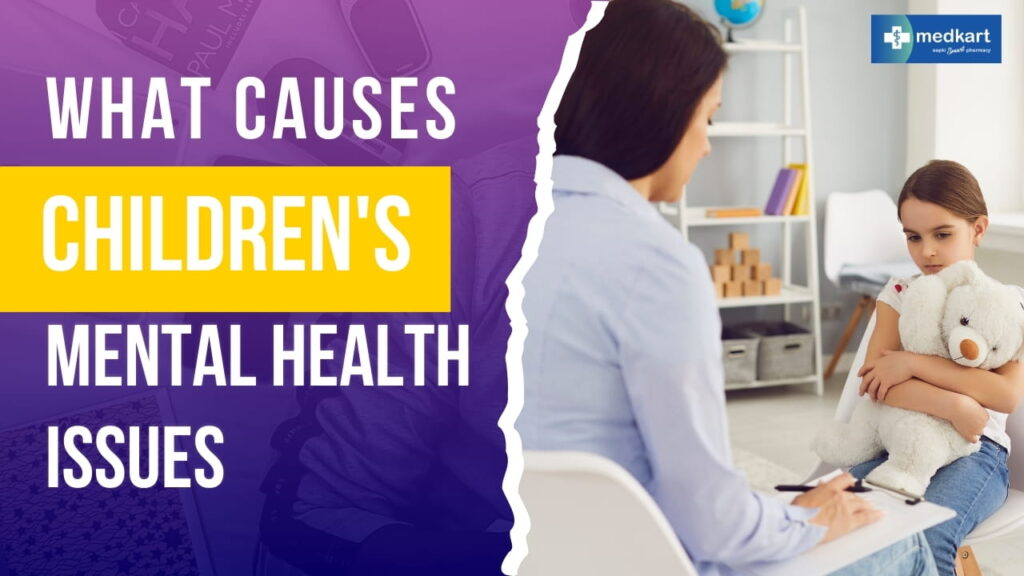Last updated on April 11th, 2025 at 12:54 pm
 Children’s mental health issues have become a growing concern in today’s society. From anxiety and depression to behavioral disorders and attention deficits, the spectrum of challenges faced by children is vast and complex. Understanding the underlying causes of these issues and implementing effective prevention strategies is crucial for promoting the well-being of our younger generations.
Children’s mental health issues have become a growing concern in today’s society. From anxiety and depression to behavioral disorders and attention deficits, the spectrum of challenges faced by children is vast and complex. Understanding the underlying causes of these issues and implementing effective prevention strategies is crucial for promoting the well-being of our younger generations.
What Causes Children’s Mental Health Issues?
Children’s mental health issues can stem from a variety of interconnected factors, spanning biological, environmental, psychological, and social domains.
1. Genetic and Biological Factors
Genetics can play a significant role in predisposing children to mental health issues. Certain genetic variations and predispositions can increase susceptibility to conditions such as depression, anxiety disorders, bipolar disorder, and schizophrenia. For example, studies have shown that children with a family history of mental illness are at a higher risk of developing similar conditions themselves. Additionally, imbalances in brain chemistry, neurotransmitter function, and neural circuitry can contribute to the onset and manifestation of mental health disorders in children.
2. Environmental Influences
The environment in which a child grows and develops plays a critical role in shaping their mental health. Adverse childhood experiences (ACEs) such as trauma, abuse, neglect, or exposure to violence can have profound and long-lasting effects on a child’s psychological well-being. These experiences can disrupt normal development, leading to increased vulnerability to mental health issues later in life. Furthermore, socioeconomic factors, including poverty, housing instability, food insecurity, and lack of access to healthcare, can exacerbate stress and contribute to the development of mental health challenges in children.
3. Psychological and Emotional Stressors
Children are susceptible to various psychological and emotional stressors that can impact their mental health. High levels of academic pressure, bullying, social rejection or isolation, peer pressure, family conflicts, divorce, loss of a loved one, and exposure to chronic stress can all contribute to the development of mental health issues such as depression, anxiety, and post-traumatic stress disorder (PTSD). Additionally, unrealistic expectations from parents, caregivers, or societal norms can create undue pressure and negatively affect a child’s self-esteem and emotional well-being.
4. Neurodevelopmental Factors
Neurodevelopmental disorders such as autism spectrum disorder (ASD), attention-deficit/hyperactivity disorder (ADHD), and learning disabilities are characterized by atypical brain development and functioning. These conditions can significantly impact a child’s cognitive, social, and emotional functioning, leading to challenges in various areas of life. Children with neurodevelopmental disorders may experience difficulties with communication, social interaction, behavior regulation, attention, and academic performance, which can contribute to feelings of frustration, low self-esteem, and mental health issues if not properly addressed.
5. Family Dynamics and Relationships
Family dynamics and the quality of parent-child relationships can profoundly influence a child’s mental health. Children who grow up in nurturing, supportive, and emotionally responsive environments tend to have better psychological outcomes compared to those who experience family dysfunction, conflict, or instability. Positive parent-child relationships characterized by warmth, affection, effective communication, and consistent discipline can promote emotional security and resilience in children. Conversely, dysfunctional family dynamics, parental conflict, marital discord, parental substance abuse, or mental illness can increase a child’s risk of developing mental health issues.
6. Social and Cultural Influences
Social and cultural factors can also shape children’s mental health experiences. Cultural norms, beliefs, values, and attitudes toward mental health and help-seeking behavior can influence how children perceive and express their emotional distress. Stigma surrounding mental illness, discrimination, social marginalization, and lack of culturally sensitive mental health services can pose additional barriers to accessing care for children from diverse backgrounds. Furthermore, societal pressures related to body image, gender expectations, academic achievement, and social conformity can contribute to stress and mental health challenges in children.

Prevention Strategies for Children’s Mental Health Issues
Prevention strategies for children’s mental health issues encompass a broad range of approaches aimed at promoting healthy development, resilience, and well-being. Here’s an in-depth look at some key prevention strategies:
1. Early Intervention and Screening
Early intervention involves identifying and addressing mental health concerns in children as early as possible. Regular screenings for developmental delays, behavioral problems, and emotional disturbances can help detect issues at an early stage, allowing for timely intervention and support. Healthcare providers, educators, and parents play a crucial role in recognizing warning signs and seeking appropriate interventions.
2. Promoting Resilience and Coping Skills
Resilience denotes the capacity to rebound from adversity and flourish amidst challenges. Teaching children resilience-building skills equips them with the tools they need to cope effectively with stressors and setbacks. This includes teaching problem-solving skills, emotional regulation techniques, positive thinking patterns, and healthy coping mechanisms such as mindfulness, relaxation exercises, and engaging in hobbies and activities they enjoy.
3. Creating Supportive Environments
Creating supportive environments at home, school, and in the community is essential for promoting children’s mental health. Supportive environments are characterized by positive relationships, open communication, and a sense of safety and belonging. Parents, teachers, peers, and community members all play a role in creating environments that foster emotional well-being and resilience in children.
4. Strengthening Family Relationships
Strong and supportive family relationships serve as a protective factor against children’s mental health issues. Parents can promote positive parent-child relationships by providing love, support, and guidance, fostering open communication, setting clear boundaries, and being involved in their child’s life. Family therapy and parent training programs can also be beneficial in strengthening family relationships and addressing issues that may impact children’s mental health.

5. Educating Parents and Caregivers
Educating parents and caregivers about child development, positive parenting practices, and recognizing signs of mental health issues is essential for early intervention and prevention. Providing parenting classes, workshops, and support groups can help parents develop the knowledge and skills they need to support their children’s emotional and psychological well-being effectively. Parent education programs can also help reduce parental stress and improve parent-child relationships.
6. Providing Access to Mental Health Services
Ensuring access to mental health services and support resources is crucial for children who may be experiencing mental health challenges. This includes access to mental health professionals such as therapists, counselors, and psychiatrists, as well as community-based support programs and interventions. Schools can play a role in providing mental health services through school counselors, psychologists, and support groups.
7. Addressing Bullying and Peer Relationships
Bullying and peer relationships can have a significant impact on children’s mental health. Schools and communities can implement anti-bullying programs and initiatives to create safe and inclusive environments where children feel supported and valued. Teaching empathy, conflict resolution skills, and positive peer interaction can also help foster healthy peer relationships and reduce the risk of bullying.
8. Reducing Stigma and Promoting Awareness
Addressing stigma surrounding mental health issues is critical for promoting early intervention and support-seeking behaviors in children. Promoting awareness, challenging stereotypes, and fostering empathy and understanding can help reduce stigma and create a culture of acceptance and support for children facing mental health challenges. Schools, media, and community organizations can play a role in promoting mental health awareness and reducing stigma through education and advocacy efforts.
Conclusion:
Children’s mental health issues are influenced by a complex interplay of genetic, environmental, psychological, and social factors. By understanding the root causes of these issues and implementing effective prevention strategies, we can work towards promoting the mental health and well-being of children. Early intervention, resilience-building, supportive environments, access to services, and stigma reduction are key components of a comprehensive approach to preventing children’s mental health issues and fostering healthy development. As a society, it is our collective responsibility to prioritize the mental health needs of our younger generations and ensure that every child has the opportunity to thrive emotionally, psychologically, and socially.
FAQs On What Causes Children’s Mental Health Issues? And How To Prevent It?
Q1. What are the main causes of children’s mental health issues?
Children’s mental health issues are caused by a combination of genetic, environmental, psychological, and neurodevelopmental factors. Genetics can predispose children to certain conditions, while adverse experiences such as trauma, abuse, and neglect play significant roles. Psychological stressors like academic pressure and social isolation also contribute to mental health challenges.
Q2. How can early intervention help prevent mental health issues in children?
Early intervention helps by identifying and addressing mental health concerns before they become severe, allowing for timely support and treatment. Regular screenings and early identification of behavioral and emotional issues can lead to better outcomes. Intervening early can reduce the long-term impact of mental health problems and promote healthier development.
Q3. What role do parents play in preventing children’s mental health issues?
Parents play a crucial role by creating a supportive and nurturing environment, fostering open communication, and modeling healthy coping mechanisms. Educating themselves on positive parenting practices and recognizing signs of mental health issues are vital steps. By being involved and supportive, parents can significantly contribute to their children’s emotional and psychological well-being.
Related Links:
9 Positive lifestyle changes for healthy life
12 Healthy Sleep Habits for Adults
